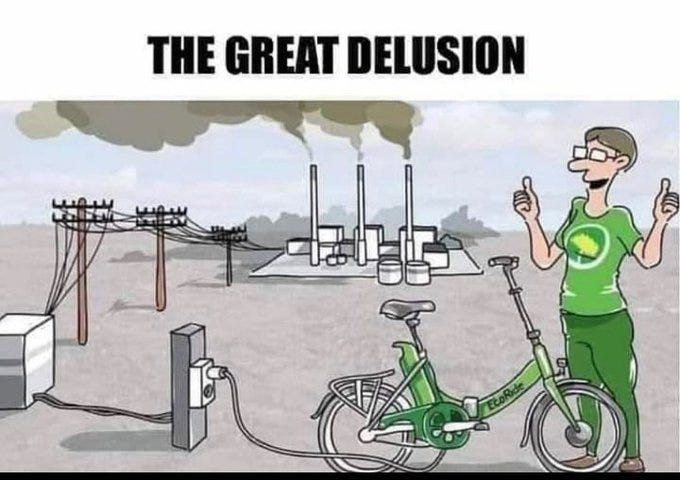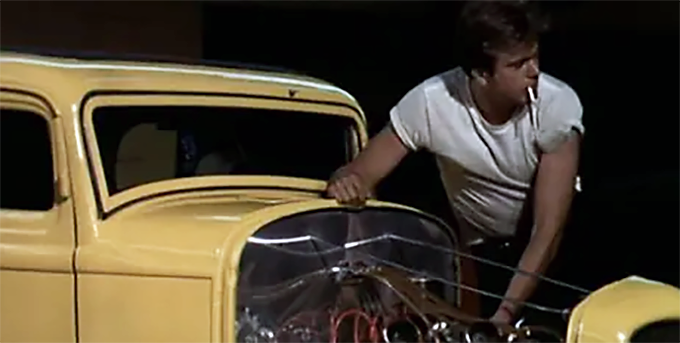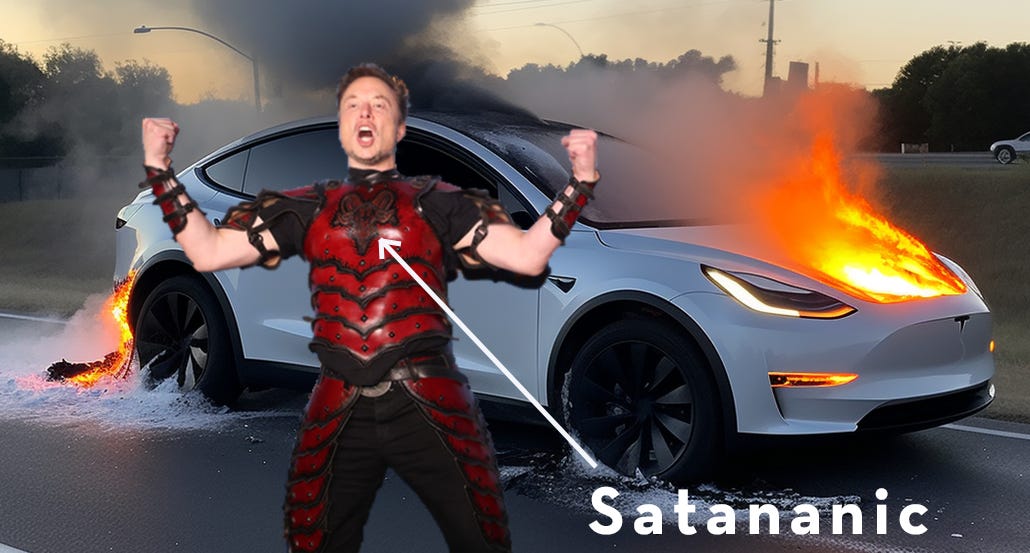E.V.irtue Signaling
The electric vehicle will soon be like the medical face mask—another public display of low IQ.
See it’s not just a car, it’s a total image. An identity.
— Bill Paxton
True Lies
Every day billions of humans around the world make consumer decisions.
Some of those consumer decisions involve purchasing a motor vehicle.
And until recently the free market functioned as it should, without the government nudging the behavior of consumers with lies and tax incentives to be funded on the backs of hard-working Americans who were neither fooled nor nudged.
Consumers used to look at motor vehicles and make decisions based on metrics such as economics, practicality, utility, reliability, gas mileage, depreciation, and sometimes less important metrics like speed, fun, looks, and social status tied to brand identity.
Those going through a mid-life crisis may have made impulsive consumer choices, often influenced by vain metrics associated with sports cars and supercars, such as the power of a motor vehicle to serve as a “pussy magnet” because every middle-aged man is familiar with life’s three certainties:
Death
Taxes
The vette gets em’ wet.
Tesla Motors was founded in 2003 by Mark Tarpenning and Martin Everhard. Elon Musk invested $6.5 million and appointed himself chairman of the board. A few years later he raised $30 million with help from the Google Founders. The investment came with the condition the he be named founder of the company. Then he proceeded to push out the founders, rewrote the history of the company to erase their names, and crowned himself the self-made “genius” behind the EV revolution.
This entire “revolution” is premised on the lie of “global warming” and “climate change.” The farcical assumption rooted in doctored “science” that somehow anthropomorphic-caused increases in atmospheric Co2 levels will cause the planet to warm anywhere from 1-3 degrees Celsius by the end of this century. Co2, also known as the gas of life, increases vegetation and the “greening” of the planet, thereby enriching animal life. Presently Co2 levels are normal if not lower than the historical average.
For example, 65 million years ago they may have been as high as 1700ppm. While a million years ago they were still over 1000ppm, compared to today’s figure of ~400ppm. At any rate, there is absolutely zero evidence that moderately increasing Co2 levels will cause any problems for humans, animals, or the planet, which is a complex self-correcting system that will see species come and go regardless of human behavior and is more affected by solar cycles than anything else.
Yet here we are with two or more generations brainwashed and indoctrinated into believing a psychological operation posing as a climate emergency which has given rise to brands like Tesla Motors.
Have consumers around the world been fooled into making many decisions about their lives, not just bodily autonomy, that give greater power to the states working for a global technocratic cabal while restricting their liberties and harming themselves physically and financially?
The answer appears to be a resounding Yes!
EVs, veganism, vaccines, paying for carbon credits. These are just the first of many scams that come to mind. While EVs are not the deadliest consumer choice one can make today, (unless you happen to be one of the hundreds of unlucky drivers trapped inside one after a crash as it spontaneously combusts and firefighters have to wait four days for the lithium batteries to burn themselves out before they can recover your charred remains) they are costly in more ways than boiling to death inside a white egg.
Of all the EVs to choose from Tesla is still the most popular brand maintaining a dominant share of the Western EV market.
What is a Tesla other than a glorified electric golf cart with an iPad that can be controlled remotely and monitored by the state at all times?
Are the government tax credits worth it? Does following anything the government “incentivizes” ever work out for the best interest of consumers or citizens?
Does it make sense to pay a $1000 monthly payment to Tesla Financial, plus nearly twice the national average for insurance, to wait an hour or longer at a Tesla charging station to “fill up” with what is often coal power?
Has Tesla become a consumer symbol of stupidity, depravity, and obnoxiousness in our twenty-first-century late-stage empire clown world?
These are important questions that Good Citizens need answers to, provided by someone who despite an unhealthy bias, will attempt to be objective.
The truth is, I’m revolted by the sight of these buzzing, humming, EMF toxic death traps for total state surveillance and control of individuals’ liberties, and cannot comprehend why anyone would own one.
For now let’s ignore the incredibly stupid high cost of the vehicles, the ridiculous price of repairs and battery replacement which has driven up insurance premiums, the ethical and moral considerations of children in Africa mining elements for those batteries, the lack of aesthetics, the very high levels of sperm and ovum destroying radiation frequencies in the cockpit, the consistently low consumer report ratings, and its dickhead owner (not founder)—the personification of the Dunning-Kruger effect who Blackrock and Vanguard made the richest man in the world (apart from the Rothschilds) by buying up Tesla stock so the market cap of this electric golf cart company was greater than ALL OTHER automobile manufactures combined, and who works for the global cabal of social engineers pushing everything around Agenda 2030—and let’s just focus on those big three reasons consumers claim to buy a Tesla: practicality, cost savings, and “because it’s environmentally friendly.”
Against these three consumer reasons, we’ll rate one of the most popular and simplest models of Tesla, a Standard Model 3, against a popular petrol-hybrid alternative.
For this side-by-side to be scientifically sound, we’ll need a petrol car that is practical, cost-effective, and with a solid pedigree.
When I searched for my first car to buy out of college, just after landing my first “real job” I asked a mechanic friend what the most practical, reliable, and efficient car would be. When he probed for more specifics I replied, “good gas mileage, cheap to repair and maintain, and will go forever.”
His answer?
“Toyota, or Honda. If you’re looking for something that will go forever those Honda VTEC engines will do the job if you just maintain them consistently. Come to think of it, even if you don’t maintain them consistently, they’ll still go forever.”
When I asked specifically how long “forever” was in car years he said he’d seen some in the shop with over 250k miles that weren’t well maintained but were still going strong.
For this exercise, we’ll use a mid-range model of the popular Honda Accord, and let’s add the hybrid version to give the comparison some similarities.
We’ll use the 2022 models of each car.
Tesla Model 3 Standard | Honda Accord Hybrid
Practicality
There doesn’t appear to be anything practical about paying $20,000 more for a rear-wheel drive electric car, that won’t do well in any kind of perilous winter weather.
If the temperature drops below even 40F (5C) the range of the EV immediately goes down because the battery needs to allocate energy to keep itself functional. Most EVs are designed to boost their battery temperatures when the thermometer drops, and this comes from the battery itself, reducing range and extending charging times.
Now, let’s assume the Tesla owner hasn’t paid thousands more ($1500-$3000) to install a home charging station in his garage and is forced to use only public charging stations. How much time each year does the Honda Accord Hybrid owner save by filling up the “old fashioned” way at the gas station?
For the Tesla Model 3:
Fill-up time: 30-50 minutes (30 - DC Fast charging only and depending on weather)
Frequency: 24 times per year (2 times per month)
Total yearly fill-up time = 50 minutes * 24
For the Honda Accord:
Fill-up time: 5 minutes
Frequency: 24 times per year (2 times per month)
Total yearly fill-up time = 5 minutes * 24
The Honda Accord owner saves 18 hours per year compared to a Tesla Model 3 owner, based on filling up ONLY twice per month with the given fill-up times. In addition to the $20,000 in savings from the car price, the Honda owner has nearly one surplus day each year compared to the Telsa owner.
But this isn’t really an apples-to-apples comparison. Since the Tesla’s range is only 272 miles, and the average American drives 13,500 miles per year, the Tesla owner would need to fully charge their golf cart 4.2 times per month to match the same range as the Accord.
That means the Honda owner gains 1.5 days per year not wasting time at a public charging station over the Tesla owner IF no other Teslas are waiting around in line. In Oregon, California, and other communist blue states filled with half-wits who have fallen for the climate scam and the lies of its PT Barnum frontman, waiting times can often be hours.
What about cost savings, the second factor cited by Tesla owners in their consumer decision rankings?
Insurance is more for the Tesla. The cost of replacing those batteries after warranties expire is nearly prohibitive for insurance companies. A simple side-by-side quote from a prominent insurance company shows higher comprehensive and collision insurance for a middle-aged fully employed driver with excellent credit and a clean driving record.
What about the cost of “filling the tank” versus charging the battery on a more than generous 287-mile range per charge? Surely, the Tesla must beat the Honda in this category.
Oof.
Tesla Model 3:
Cost to fully charge: $12
Range per full charge: 287 miles
Cost per mile: $\frac{$12}{287}$ miles
Cost per 1,000 miles: $12 / 287 \times 1000 = $41.81
Honda Accord Hybrid:
Cost to fill the tank: $12.8 \times $3 = $38.4
Range per full tank: 608 miles
Cost per mile: $\frac{$38.4}{608}$ miles
Cost per 1,000 miles: $38.4 / 608 \times 1000 = $63.16
Tesla Model 3: $41.81
Honda Accord Hybrid: $63.16
The savings per 1,000 miles driving the Tesla, compared to the Honda Accord Hybrid, is approximately $21.35.
Annually, based on the average mileage of 13,500 miles, the savings amount to roughly $288.22.
To accumulate $20,000 in savings at this annual rate would take approximately….
69.39 years
For shits and giggles let’s use the popular Model X, with the cool gullwing doors.
Tesla Model X:
Cost to fully charge: $18
Range per full charge: 330 miles
Cost per mile: $\frac{$18}{330}$ miles
Cost per 1,000 miles: $18 / 330\times 1000 = $54.55
Honda Accord Hybrid:
Cost to fill the tank: 12.8 gal \times $3/gal = $38.4
Range per full tank: 608 miles
Cost per mile: $\frac{$38.4}{608}$ miles
Cost per 1,000 miles: $38.4 / 608 \times 1000 = $63.16
Tesla Model X: $54.55
Honda Accord Hybrid: $63.16
The crazy thing is that Model X costs an average of $40,000 more. The annual savings from driving the Tesla Model X instead of the Honda Accord Hybrid, based on 13,500 miles per year, is approximately $116.23. To save $40,000 by driving the Tesla Model X it would take approximately…
344.13 years
Congratulations Tesla X owners. You’ll be better off than the Honda Accord Hybrid owner sometime around Easter of the year 2368.
Even if gas were $5 per gallon, the Accord would still offer greater savings on purchase price and insurance alone. If the purchase price difference is $20,000 from the Model 3, how many years would you need to own the Tesla at the average rate of 13,500 miles Americans drive to save on gas just to break even with the Honda Accord Hybrid?
With gasoline priced at $5 per gallon for the Honda Accord Hybrid:
Tesla Model 3:
Cost per 1,000 miles: $62.72
Honda Accord Hybrid (with gas at $5 per gallon):
Cost per 1,000 miles: $105.26
Based on the average annual mileage of 13,500 miles, driving a Tesla Model 3 instead of a Honda Accord Hybrid (with gas at $5 per gallon) would result in annual savings of approximately $574.29. To save $20,000 at this rate of savings, would take about 34.83 years, and this doesn’t include the extra $34,000 in insurance premiums the Tesla owner would pay over that same time compared to the Accord Hybrid.
Let’s summarize this consumer decision so far:
higher insurance
lose $20,000 immediately
weather prohibitive
lose 1.5 days per year
get your nuts and jizzum constantly radiated
all to save $288 per year on “gas”
What about those “environmentally friendly” claims Tesla owners use to justify their consumer decisions?
“Clean” Energy
An older study recently made headlines again. Since EVs weigh so much more than petrol cars they wear out their tire treads faster. The toxic chemicals released into the air are 400 times worse than petrol exhaust emissions. They probably don’t tell bugmen buyers that on the Tesla lot.
The economics of the climate hoax require a great deal of thought, calculations, projections, and cutting through the bullshit. Thankfully Substack is full of thoughtful and talented people who have already done this work. The globalist ambition to transition to Net Zero (carbon neutral) energy production by 2050 is so economically and civilizationally unfeasible, that anytime anyone uses any of this technocratic jargon they should be immediately laughed out of any room.
Last spring I came across the fourth part of a series on the scam of Net Zero by JP who writes Bush Food Forager. It was a probing deep dive into the data and economics of a projected “clean energy transition” for Australia.
It’s in part three where he explores the replacement of all ICE’s with EVs. He shows the energy calculations for ships, trains, and planes as well based on Simon Michaux’s 2021 bombshell report that is 1000 pages long and 78MB as a PDF file.
Here we return to Simon Michaux’s August 2021 report, “Assessment of the Extra Capacity Required of Alternative Energy Electrical Power Systems to Completely Replace Fossil Fuels,” to explore a hypothetical transition of the entirety of the world’s transportation infrastructure away from oil and gas to clean renewables. Taking the lead from Michaux, we will be exploring his Scenario A (replace all combustion engines with EVs), Scenario C (replace all combustion engines with hydrogen fuel cells) and Scenario D (replace fossil fuels with biofuels).
In part 3’s EV section JP breaks down Michaux’s report by total vehicles on earth and the amount of Li-Ion batters needed to transition the world’s fleet of over 1.6 billion vehicles (2022). In 2018 it would have required 339 million tonnes of Lithium Ion batteries. Not only do the resource production and extraction capacities for this not exist in 2024, they will not even come close to existing by the end of the century.
The entire four-part series is well worth the read if you don’t have the time to sift through a 1,000-page report. JP does an excellent job of pulling the main figures from the report and assembling them into a coherent and comprehensive summary that so thoroughly debunks the “clean energy” transition scam, you’d have to be an autistic Swedish teenage girl with abusive Marxist parents to buy into all this bullshit.
Since minerals that compose Li-Ion batters (lithium, cobalt, manganese, nickel, and graphite) require ICEs to mine and extract (when not using poor African children), the Co2 emissions to simply extract these elements, distribute them to factories, manufacture them for batteries, and distribute those to the assembly plants, a process known as Lifecycle Production, far exceed the first 3 years of ICE “dirty emissions” savings for every battery pack “mined and produced” and transported to the factory for its final installation into an EV assuming that EV is charged using neutral sources like hydroelectricity. If that EV is charged using coal power, there is no “dirty emissions” savings at all. Given the toxic emissions from tire tread wear of EVs are 400x worse than petrol emissions, it’s all one grand delusion.
Enter Austrians
The consumer is the king... his majesty is sovereign in directing all economic activities. By his buying and abstention from buying, he decides about the income of the sellers and about the fate of the producers.
— Ludwig von Mises
In the discourse on economic philosophy, the Austrian School robustly champions the free market as a self-correcting mechanism, underscoring consumer choice as the driver shaping the future of businesses and industries. Figures such as Friedrich Hayek, Ludwig von Mises, and the precursory insights of Frédéric Bastiat, laid the foundation for a rich understanding of how individual preferences and entrepreneurial spirit naturally guide economic progress, negating the necessity for centralized control.
Within the frame of modern debates on government efforts to direct consumer behavior, particularly through tax credits for consumers or tax subsidies for producers of EVs, the Austrians would be horrified by the levels of omnipresent market manipulation.
Friedrich Hayek stressed that the price system was an essential medium for transmitting information, ensuring resources align with consumer demands. Hayek would view current government incentives as interventions that warp the critical signals of authentic price discovery, resulting in resource misallocation and potentially stifling innovation outside government preferences.
Ludwig von Mises, renowned for championing consumer sovereignty and the role of entrepreneurship, would argue that the market's voluntary choices should dictate industry success, including that of EVs, rather than government mandates for a fabricated climate emergency.
Mises might see current policies as an erosion of consumer sovereignty, where artificial incentives favor certain technologies, impairing the market's self-corrective capability and innovation according to true demand.
Frédéric Bastiat, an advocate for economic freedom and minimal government intervention, would perceive the push for EVs as an example of what he termed the "great fiction," where societal resources are misallocated through state action. Bastiat would warn against the unintended consequences of such policies, pointing to inefficiencies and societal resource misallocation.
The Austrian School championed the market's ability to self-regulate via supply and demand and enterprise successes driven by consumer choices, not by government decrees or global technocratic agendas.
A truly free market, unhampered by government interference (or Blackrock and Vanguard blackmail), is the optimal setting for discovering efficient and sustainable solutions to challenges, including environmental issues.
The absence of free market dynamics combined with the pervasive nudging of consumer behavior has ensured that the very thing those pushing EVs claim to want to reduce is only increased by their solution. The carbon “footprint” of the lifecycle of EV production, in addition to toxic emissions from tires, is far worse than the very “problem” they set out to solve with petrol emissions.
But when one understands that this “government intervention” was never about clean energy and always about controlling and monitoring citizens and their transportation liberties, then it makes perfect sense why they would want to tie them to their power grids in electric golf carts filled with computers that can be monitored and controlled remotely.
If any remnants of a free market still existed, their self-correcting nature would eventually kick in when businesses began to suffer losses. This would drive demand down, thereby increasing supply and forcing the EV market to correct prices.
It appears this may finally be happening. Ford has discontinued its march toward mass EV production as dealer lots fill up with unwanted EV trucks and cars.
It turns out that nobody wants to wait around charging an EV while on a business trip or holiday. Who could have seen this coming? Not Hertz.
If Hertz dumps all their EVs, that means 34,000 used Teslas will hit the secondhand market, further driving prices down. Who would want to pay $45,000 for a new Model 3, when they can have a slightly used one for half the price?*
*Assuming they don’t read this piece and can’t do simple side-by-side comparisons with a Honda Accord Hybrid.
Tesla Owners
The popular consumer products of any period often end up becoming historical placeholders, or visual signifiers for a decade and all its triumphs and travails.
For example, what would Gustave Caibaillot’s Paris Street painting look like with douchey bugmen on electric scooters, and egg-shaped EVs in the cobblestone streets instead of couples walking with umbrellas and horse and buggy?
What would the film American Graffiti have looked like if all those guys were cruising Main Street of Anytown USA in the Tesla Model 3?
Would John Milner be revving his Telsa engine at the red light next Bob Falfa (Harrison Ford) revving his Chevy Volt engine?
Would it be cool to hear nothing at all when they both hold the brake pedal down while simultaneously tapping the accelerator?
EVs are spectacularly gay, and gay will never be cool.
What will future generations think of this brief experiment with nudging consumers toward electric vehicles that offered them no discernible benefits in any consumer categories (including “clean energy”) over petrol or hybrid versions at substantially greater economic cost?
If future generations of men ever recover any healthy levels of testosterone what will they say when they learn that Dodge ditched their roaring V8 HEMI engine of pure American muscle for spontaneously combustible batteries?
They’ll probably say what I’ve already said: EVs are spectacularly gay, and gay will never be cool.
In that sense, the Tesla is the perfect representation of the times we’re living.
Gay.
Where we are.
Where we were.
Don’t be gay
Fixed Income Pensioner Discount (honor system)
Student Discount (valid .edu email)
Thank you for sharing
The Good Citizen is now on Ko-Fi. Support more works like this with one-time or monthly donations.
Cryptastic
BTC: bc1qchkg507t0qtg27fuccgmrfnau9s3nk4kvgkwk0
LTC: LgQVM7su3dXPCpHLMsARzvVXmky1PMeDwY
XLM: GDC347O6EWCMP7N5ISSXYEL54Z7PNQZYNBQ7RVMJMFMAVT6HUNSVIP64
DASH: XtxYWFuUKPbz6eQbpQNP8As6Uxm968R9nu
XMR: 42ESfh5mdZ5f5vryjRjRzkEYWVnY7uGaaD
























All of that applies as well to the monstrous dastardly inefficient , dangerous and unhealthy wind turbines. They've taken over our once beautiful midwest farms. I'm surrounded. I can tell you first hand how these work, or rather don't work. All bullshit and in the same class as EVs.
Each and every “green” energy program is a complete scam. The devastation caused by mining the minerals for the batteries for these ridiculous EV’s is actually horrifying. The stupid inefficient windmills require more energy to make and maintain and will never recoup the costs and the grotesque damage to the environment. There are also huge windmill blade graveyards everywhere. The blades don’t last and of course cannot be recycled. The solar farms have a relatively short lifespan and are also made from extremely toxic materials. There is no plan to expend any effort whatsoever to properly dispose of these tons and tons of extremely toxic materials The unbelievably corrupt, greedy, lizard psychopath globalist cabal are literally destroying the planet and humanity itself at an astonishing rate. The only solace is knowing that after they have finished their dirt they will turn on each other like the depraved jackels that they are.